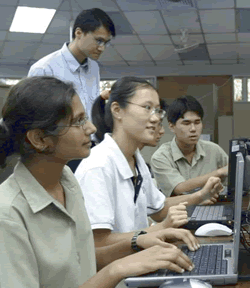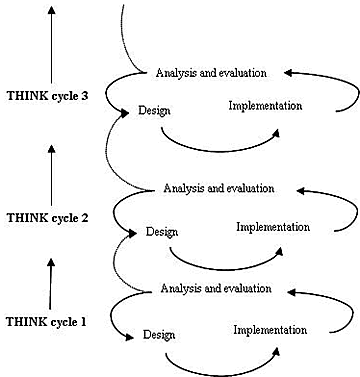Learning to THINK
NIE’s Learning Sciences Lab (LSL) and the teachers of Temasek Junior College explore how problem-based learning can help students learn science.
 The general goal of science education has shifted from an acquisition of knowledge to focus on the process of science inquiry and on thinking skills. It is moving away from learning about science to doing science, bringing the practice of real-world scientists to the classroom.
The general goal of science education has shifted from an acquisition of knowledge to focus on the process of science inquiry and on thinking skills. It is moving away from learning about science to doing science, bringing the practice of real-world scientists to the classroom.
In response to this change, schools have been trying out innovative approaches to science learning.
One approach to learning that is quickly gaining popularity in Singapore schools is problem-based learning (PBL). Keen to explore the impact of a PBL approach on students’ learning outcomes, Temasek Junior College (TJC) initiated a collaborative project with the National Institute of Education’s Learning Sciences Lab (LSL).
What is this project about?
First pioneered in the medical schools of McMaster University in Canada, PBL was not originally developed for science learning. However, it has since been adapted for use in secondary and junior college science education.
As an engaging and constructivist learning process, PBL gives students the agency and power to direct their learning, with the teacher acting as a metacognitive coach. The key features of PBL include initiation of learning with ill-defined problems in an authentic context and collaborative problem solving among students.
As the approach is adapted from a foreign context, culture and discipline, the impact of this approach on our students’ learning outcome is not immediately understood. But given its increasing popularity and its potential scalability in local schools, LSL researchers felt it was an important area of research.
What did we want to find out?
Since the PBL approach is new to many students, we need to examine how the learning environment can be designed to help students deal with the messiness of real-world problems for learning to take place. Also, when introducing a new approach, we need to collect evidence to help make informed decisions on the subsequent iterations of design.
We are interested in finding out the impact of the approach on students’ learning outcomes in terms of meaning making of science concepts, beliefs about learning, and the kind of interaction patterns that occur in the learning community. More specifically, this study aims to find out:
-
how learning can be designed to support interaction in science meaning making;
-
how students’ beliefs about science learning change in the process;
-
how interaction patterns evolve in the learning community as students engage in a problem-based learning approach.
What did we do?
Student-teacher collaboration
TJC’s science department designed a problem-centred approach to science learning, called the THINK cycle. Modelled after the PBL approach, the THINK cycle is a 5-stage instructional model for problem solving. Students go through problem-based learning using the THINK framework: Trigger, Harness, Investigate, Network and Know.
In this approach, students in TJC’s Integrated Programme work in groups of 4-5 to solve simulated real-world problems (T). They then identify learning issues that they need to investigate (H), before embarking on a series of investigations (I), which may include searching for information and testing of hypotheses. Throughout the process, students work collaboratively with their team members and teachers to find a solution to the problem (N). Finally, they present their solution to a panel of judges (teachers and classmates) to display their knowledge gained (K).
In each cycle, the teacher acts as a facilitator in the process of problem solving. A computer-supported collaborative (CSCL) system is used to mediate the interaction among the members in the problem-solving community.
Teacher-researcher collaboration
This study adopts a design-research approach, where teachers and researchers work collaboratively in designing, implementing and evaluating each THINK cycle through an iterative process (see figure below).

The researchers worked closely with the teachers to brainstorm trigger problems and to discuss the kinds of activities and tasks for the students in each cycle, as well as assessment modes for the cycle. They joined the teachers in the classroom and act as co-facilitators during the activities. They also videotaped classroom events and student interactions, collected students’ work, and interviewed the students to find out their reactions to the activities.
Weekly meetings were held to reflect on what was observed. The findings then informed the design of interventions for the next cycle.
What have we found out?
This study has been ongoing for a year. Preliminary results reveal that students in this programme have developed a more inquiring mind, seeking to refine ideas by asking higher order questions. They learned how to critique others’ ideas. They have also grown to be less reliant on teachers and are able to work with uncertainty.
The researchers also found that there needs to be a balance between problem solving and learning of science concepts and principles. For instance, while an emphasis on problem solving often elicits creative and innovative solutions from the students, sometimes, the students do it at the expense of learning intended content knowledge. They may be able to come up with innovative solutions but are unable to articulate the scientific principles that were employed. The converse is also true.
An emphasis on content knowledge often leads to decontextualised knowledge acquisition, low levels of interest in solving the problem, and individualistic attitudes. Hence, the objectives of problem solving and knowledge acquisition have to be balanced so that one does not overshadow the other.
It was found that at least at the initial stage of PBL, a more structured approach with well-defined stages of problem solving may be more beneficial to students. Each of these stages should direct students’ attention to either knowledge construction or problem solving in a more structured manner.
How teachers will benefit from the research?
Through this study, we hope to be able to provide useful knowledge for policymakers and teachers on to how to design science curricula using a PBL approach, and how to scaffold student inquiry in a technology-mediated environment. This would be relevant to schools offering the Integrated Programme as well as schools seeking to reform their science curriculum.






